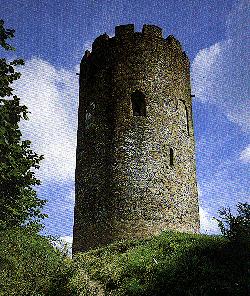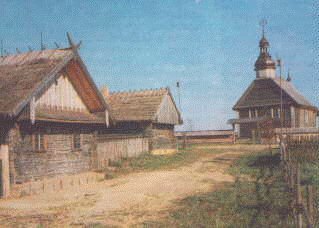 Boris and Gleb Orthodox Church Grodno, XII c.
Boris and Gleb Orthodox Church Grodno, XII c.The following dates are taken from Jan Zaprudnik's book: "Belarus: At a Crossroads in History"
These are just major dates in the history of Belarus. It seems that they give a self consistent story. You can go straight to the early period, or to the Belarusan Renaissance or to the 20th Century. If you prefer text, you can read a brief summary by Auhen Reshatau.
6th-7th centuries: Penetration of Slavs into the territory of future Belarus, already settled by Baltic tribes
8th-9th centures: Massive settlements of East Slavic tribes (Kryvichans, Drehovichans, and Radsimichans) on the territory of Belarus and their assimilation of Balts
862: First mention of Polacak (Polotsk) in the chronicle Tale of the Bygone Years
10th century: The city of Polacak (Polotsk) in Northern Belarus becomes the predominant center of power on Belarusan territory, competing with Novgorod and Kiev
980: First mention of the city Turau in a chronicle
988: Christianization of Kiev by Prince Vladimir (Volodymyr)
1044-1066: Erection in Polacak of St. Sophia Cathedral to match similar buildings in Novgorod and Kiev, as a symbol of independent power
 Boris and Gleb Orthodox Church Grodno, XII c.
Boris and Gleb Orthodox Church Grodno, XII c.12th century: Break-up of the Polacak principality into several appanages, which war among themselves and against Kiev
1120-1173: Life of St. Euphrosyne , granddaughter of Prince Usiaslau
ca.1130-ca.1182: Life of St. Kiryla (Cyril), bishop of Turau
1201: German missionaries found the city of Riga, Latvia's capital today
1214: Polacak loses to the Knights of the Sword its western vassal cities on the banks of Dvina
1228: Polish Prince Konrad of Masovia invites to his realm the German Christian warriors known as the Knights of the Cross, who make constant military incursions into Lithuanian, Belarusan, and Muscovite lands
1237: Merger of the Knights of the Sword and the Knights of the Cross into one Teutonic Order
1240: Destruction of Kiev by the Mongols
1240-1263: Rule of Mindouh (Mindaugas), who consolidates east Lithuanian and west Belarusan territories into the Grand Duchy of Lithuania (GDL) and Rus', with a capital in Navahradak
 Bela Vezha - White Tower, XIII c.
Bela Vezha - White Tower, XIII c.1300: Dante and Giotto mark dawn of the Renaissance
1315-1341: Rule of Grand Duke Hedymin (Gediminas), who transfers the capital of the Grand Duchy of Lithuania and Rus' to Vilnia (Vilius)in 1323
1341-1377: Rule of Grand Duke Alhierd (Algirdas), who expands eastward the territory of his duchy, thereby clashing with neighboring Muscovy
1385: Grand Duke Jahaila (Jogailo, Jagiello; baptized Wladyslaw) concludes a personal union with Poland by marrying the Polish queen and promising to Catholicize Lithuania
1387, 1390, 1391: Self-government bestowed on the cities of Vilnia, Bierascie(Brest), and Hrodna (Grodno), respectively
1392: Grand Duke Vitaut recognized by king Jahaila as the independent ruler of the Grand Duchy
1410: The great Battle of Grunwald, during which the united armies of Poland and the Grand Duchy crush the Germans of the Teutonic Order
1468: King Kazimir's Code of Laws(Statut Kazimira), the first code of criminal and procedural laws of the Grand Duchy of Lithuania (written in Belarusan) in which punishment is individualized
1480: Muscovy free of the Tatar dependency
1492: Columbus reaches America
1498,1499: Self-government privilege granted to Polacak and Miensk
1500: Beginning of defensive wars of the Gand Duchy of Lithuania, Rus', and Samogitia against Muscovy (Moscow)
Early 16th century: First Belarusan printing shop founded in Vilnia
1517: Luther's Ninety-Five Theses precipitate the Protestant Reformation
1517-1519: Francisak Skaryna of Polacak translates and publishes the Bible in the Belarusan vernacular in Prague
 Front Page of Skaryna's Bible
Front Page of Skaryna's Bible1529: Adoption by the Diet Of the Great Duchy of the first code of laws, the "Statute of the Grand Duchy of Lithuania," written in Belarusan
1560s: Wave of conversion of Belarusan gentry to Calvinism
1563: Polacak occupied by Russian army
1569: Political union of the Grand Duchy of Lithuania, Rus' and Samogitia with Poland establishing the Commonwealth of Poland. Arrival of the first Jesuits in Vilnia; start of the Counter-Reformation in the Grand Duchy
 Jesuit Church in Grodno, XVII-XVIII cc.
Jesuit Church in Grodno, XVII-XVIII cc.1579: Polacak taken back from Muscovites by the army of King Stefan Batory; The Vil'na University is founded.
1581: Establishment of the Tribunal of the GDL, an appellate court that fortified the rights of the gentry
1607: Founding of Jamestown in Virginia, first of the thirteen English colonies in America
1603-1613: Muscovy's "Time of Troubles," when a Polish king of Swedish lineage, Sigismund III, tries to be accepted as Russia's tsar
1613: Election of the first Romanov tsar in Russia
1632-1634: War of the Commonwealth with Muscovy
1654: Bohdan Khmelnitsky unites Ukraine with Russia
1654-1667: War of the Commonwealth with Russia; loss of Smolensk to Muscovy
1686: Russo-Polish "Eternal Peace": Russia retains Smolensk, Chernigov, and Kiev
1696: By a decision of the Warsaw General Confederation, the Rus'ian (Old Belarusan or Old Slavic) language is replaced by Polish in official documents of the Grand Duchy of Lithuania. The Latin alphabet replaces C yrillic in popular usage
1772, 1793, 1795: Three partitions of the Polish Commonwealth among Russia, Prussia, and Austria. All of Belarus is incorporated into the Russian Empire, with the exception of a small northwestern corner, taken by Prussia. 1776: Most Belarusan cities and towns are deprived of their Magdeburg Statutes of self-government. 1789: Onset of French Revolution. American Constitution adopted.
1791: The Constitution of May 3 merges the Polish Crown and the Grand Duchy of Lithuania, Rus', and Samogitia into a unitary state.
1794: Anti-Russian uprising led by Tadeush Kosciuszko/P>
1803: The Vilnia Imperial University is founded and becomes a hotbed of Polish, Belarusan, and Lithuanian youth movements
1812: Napoleon's march into Russia
1832: Vilnia Imperial University closed down as part of the measures taken to thwart the insurrection of 1830-1831
1861: Abolition of serfdom in Russia
 Typical Village of XIX c.
Typical Village of XIX c.1863-1864: Massive anti-tsarist uprising in Poland, Belarus, and Lithuania led in Belarus by Kastus' Kalinouski
1864-1876: Opening of teacher's seminaries in Maladecna, Niasviz , Svislach, and Polacak
1864-1915: The Vilnia Archeological Commission publishes forty-nine volumes of documents pertaining to Belarusan history
1867: Russia sells Alaska to the United States
1870: Publication of The Dictionary Of the Belarusan Language by Ivan Nasovich

1917: In March, the Russian Revolution causes Tsar Nicholas II to abdicate. In November, Lenin's Bolsheviks seize power. In December, the First All-Belarusan Congress in Miensk proclaims a republican government in Belarus and is disbanded by Bolsheviks
1918: On March 9, the Executive Committee of the Council of the First All-Belarusan Congress declares Belarus a democratic Republic
1919-1921: The Russo-Polish War results in the partitioning of Belarus between the Byelorussian Soviet Socialist Republic and Poland
1927: Massive arests of the leaders of the Belarusan Peasant-and-Workers' Hramada are made by Polish authorities
1928: The Institute of Belarusan Culture is renamed the Belarusan Academy of Sciences, with Usievalad Ihnatouski as president
1936: Closure by the Polish authorities of the Belarusan Institute of Economy and Culture and the Belarusan School Society in Vilnia
1937-1941: Operation of Soviet death camp in Kuropaty near Miensk, where up to 250,000 civil victims may have been executed as a result of Stalinist genocide
1939: On September 1, Germany attacks Poland and World War II begins
On September 17, Red Army moves into West Belarus and West Ukraine
On October 10, Moscow transfers Vilnia from the Belarusan SSR to the Lithuanian SSR
1941-1944: The German occupation of Belarus results in the deaths of 2.2 million people, the destruction of 209 cities and townships, and 9,200 villages, and uncounted material losses
1944: At the Moscow conference (October 9-22), the Polish delegation agrees to accept the Curzon Line as Poland's eastern frontier
1945: On April 25, delegates from Belarus and Ukraine are invited to the San Francisco Conference. Recognized for their role in the war effort, both countries become members of the United Nations
1953: Stalin dies
 Belarusan Giant - BelAZ
Belarusan Giant - BelAZ1986: On April 26, our biggiest tragedy - The Chernobyl explosion. Seventy percent of the fallout covers southeastern Belarus with radioactive dust. It will stay there for thousands of years
1991: On August 25, Belarus declares independence
On December 8, Russia, Belarus, and Ukraine form the Commonwealth of Independent States. The Soviet Union comes to a virtual end
To order Jan Zaprudnik's book about Belarus, contact Harper Collins (works in US at least; don't know about from other countries):
Order number: 1-800-822-4090 fax: 1-800-242-7737
Jan Zaprudnik, "Belarus: At a Crossroads in History," Westview Press (now part of Harper Collins), 1993, ISBN: 0-8133-1794-0 (pbk.)
Harper Collins also has a web page at: http://www.harpercollins.com/
For other sites having material related to the history of Belarus see:
There is also great site on Belarusan Heritage maintained by Aliaksiej Sierka.
The Jews of Moscow, Kiev and Minsk. Identity, Antisemitism, Emigration by Robert J. Brym
Vilnius University Library on-line catalog (telnet, login OPAC, password OPAC)
I would appreciate your comments and suggestions on the VG to Belarus " My address"